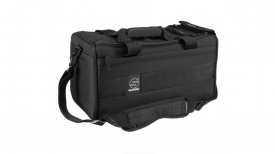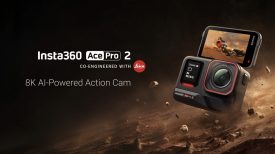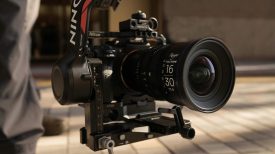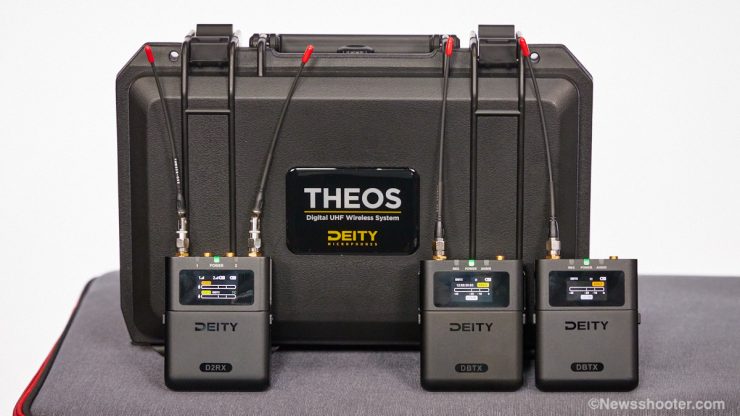
The Deity Theos Digital Wireless Microphone System is an all-new wireless kit that brings Deity into the wideband UHF spectrum rather than the crowded 2.4 GHz band. This should make the wireless system more reliable in more areas. I had a peek at the new system at NAB 2023.
Due to component availability issues, Deity has retired two wireless systems: the Deity Microphones Connect Timecode Kit and the Deity Microphones BP-TRX. The smaller Deity Microphones Pocket Wireless Digital Microphone System is still available. Instead of figuring out how to make the former models with different components, they returned to the drawing board, and the THEOS was born.
Deity THEOS is a feature-rich UHF wireless audio system with a Micro SD card slot in the transmitter for recording. It can record 32-bit float while transmitting, making the system versatile, but there is a catch. You can’t record and transmit in the US, as Zaxcom has a patent. More on this later.
It also features timecode built in that seamlessly works with the Deity TC-1 Wireless Timecode Generator and the TC-SL1 Wireless Timecode Smart Slate. Deity now has a powerful wireless audio capture and timecode-generating ecosystem. Oh, and yes. Batteries are included!
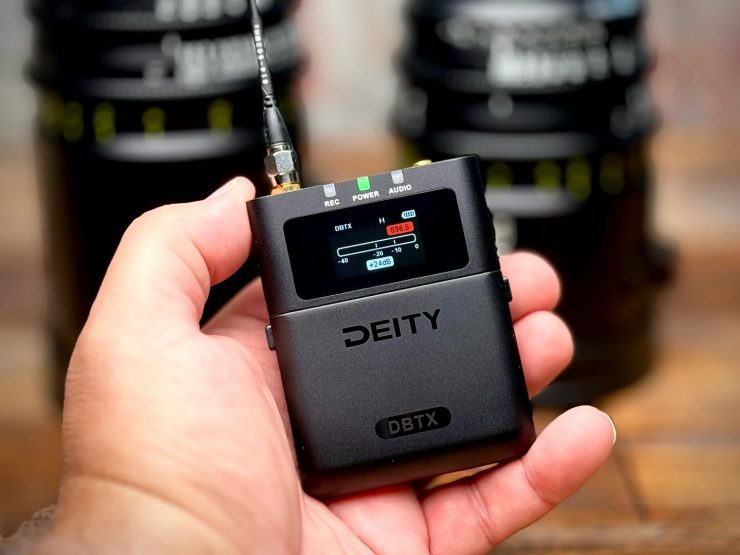
As you can see, the production model sports a more subtle look, with the branding glossy black on the matte finish. I like the new look as it doesn’t distract if they end up on camera.
What’s Included
The kit contains everything you need to capture audio, including Micro SD Cards and batteries!
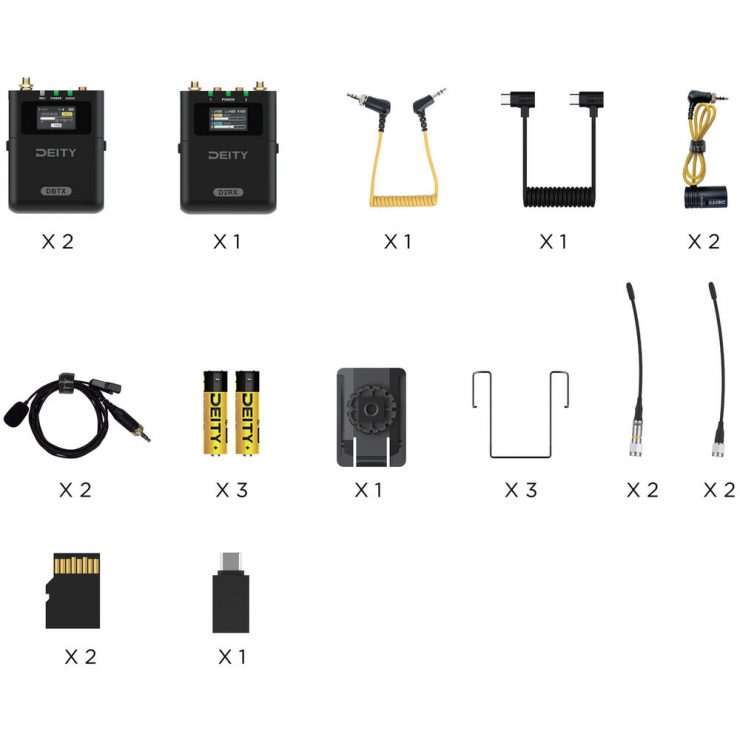
- Deity Microphones Theos D2RX Digital Camera-Mount Wireless Microphone Receiver (550 to 663 MHz) (retails for $339)
- 2 x Deity Microphones Theos DBTX Digital Wireless Bodypack Transmitter with Omni Lavalier Microphone (550 to 663 MHz) (retails for $399)
- 2 x Deity Microphones W.Lav Pro Omni Lavalier Microphone (Black) (retails for $120 each)
- 2 x RX-Link Cable
- C12 TRS to TRS Cable
- 6 x AA Battery
- 12 x Antenna (Various Frequency Bands)
- 3 x Belt Clip
- Cold Shoe Adapter
- Water-Resistant Hard Case
- 2 x 32GB Micro SD Cards
- Limited 30-Month Manufacturer Warranty
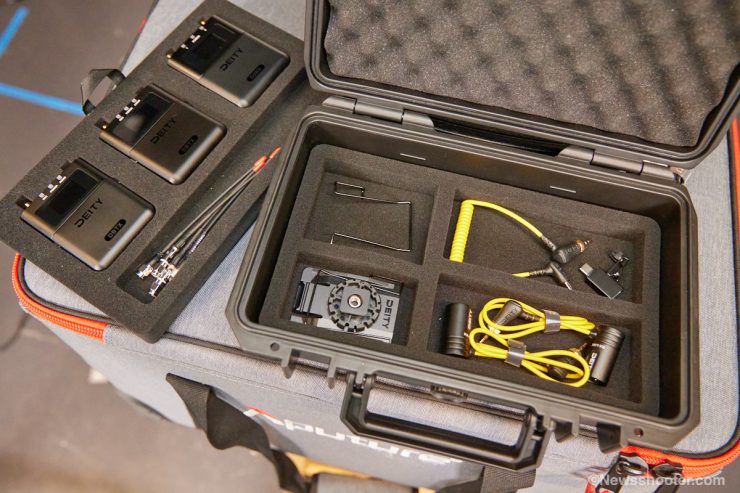
The kit is complete, that is for sure, and having an included hard case is another plus. The case has a removable top tray and more storage for cables and accessories.
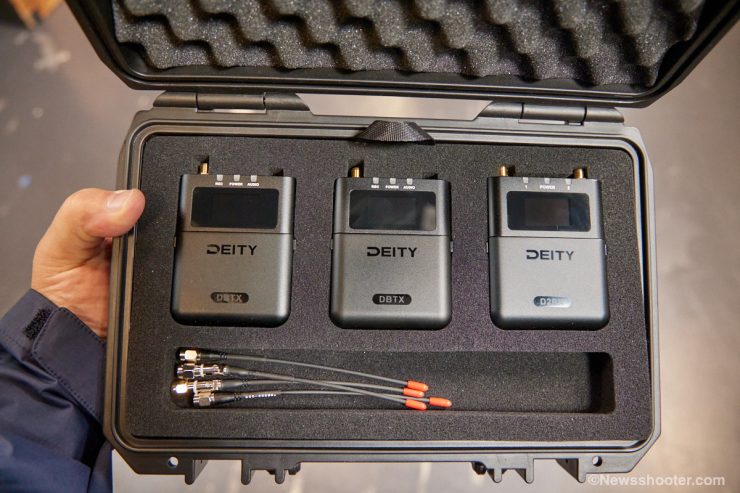
It’s all nice and tidy; however, you must take the antennas off to store them. Leaving the cold shoe mount and belt clip on works, and the lid closes.
Global OneBand
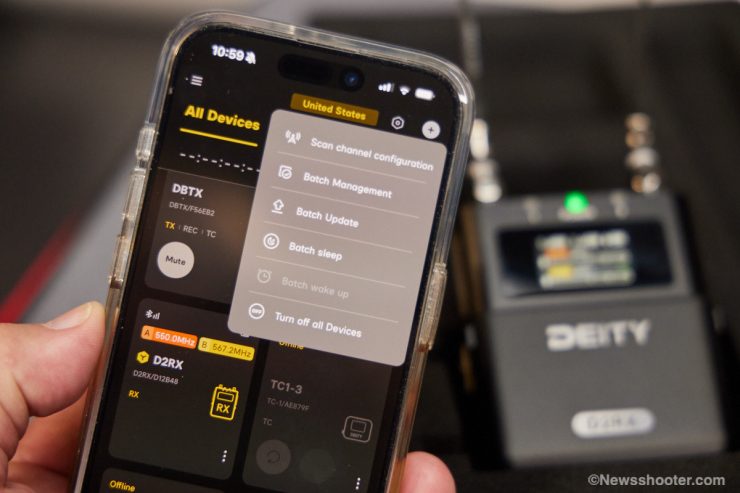
The Deity THEOS Digital Wireless Microphone System is a one-world model, but it works differently depending on the location you are using it in. This is due to the frequencies available for wireless devices. The THEOS will switch to the region’s settings when traveling to a different country with different UHF bands and frequency laws. This is done with your phone’s GPS and the Sidus Audio app.
All US Theos Digital Wireless devices will support multiple bands for a total of 96 MHz of available spectrum.
550-608 MHz UHF TV Band
614-616 MHz Guard Band
653-663 MHz Duplex Gap
902-928 MHz ISM Band
Local laws limit the actual spectrum. See your government’s rules on RF spectrum for wireless microphones.
Deity Theos Key features
- Dual Channel Receiver
- Global OneBand™ technology; 550-960 MHz*
- Built-in 32-bit float alternative recorder in the transmitter
- Recordings are saved to a Micro SD card; up to 128Gb
- Both the transmitter and receiver can be remotely controlled via the Sidus Audio™ app
- Up to 14hrs of battery life with Deity-branded lithium batteries
- Full-color LCD screen
- CNC-milled aluminum chassis
- SMA antenna ports
- *actual frequency band size will be limited to local country laws and regulations
Specifications
| Transmitter: |
| RF Modulation: Proprietary Digital RF Modulation |
| RF Power – 10mW, 25mW, 50mW, 100mW |
| RF Spectrum – 550 ~ 940Mhz* |
| RF Frequency Step:100KHz |
| RF Spacing: 700KHz |
| Antenna Connector: 50 Ω SMA |
| Dynamic Range: 123dB |
| Distortion: <0.5% |
| Frequency Response: 20~20KHz |
| Low Cut: 0FF/75Hz/100Hz/150Hz |
| Mic Power: MIC-3V、LINE |
| Mic Connector: 3.5mm TRS |
| Input Gain: 0~+30dBV |
| ADC Bit-Depth: 24 |
| ADC Sampling-Rate:48 |
| Timecode Reader / Generator: |
| Clock Accuracy: 0.15 PPM (1 Frame Out in 72 Hours) |
| Timecode Type: LTC(SMPTE) |
| Timecode Frame-Rates: 23.98, 24, 25, 29.97, 29.97DF, 30, 30DF |
| Internal Recording: |
| Media: MicroSD Card (Flash Memory) |
| File Format: .wav BWF |
| Record Format:24 / 32bit float |
| EIN: -132dBV (-130dBu) max (A-weighting, gain= 30dB, 150ohm source impedance) |
| Receiver: |
| RF Frequency Step:100KHz |
| RF Spacing: 700KHz |
| Antenna Connector: 50 Ω SSMA |
| Sensitivity: -95dBm |
| Receiver Audio: Analog Output (x 2) |
| Dynamic Range:103dB |
| Distortion: <0.5% |
| DAC Bit-Depth:24 |
| Output Type: Mono, Stereo, Headphone |
| *Actual spectrum is limited by local laws. See your government’s rules on RF spectrum for wireless microphones |
Mounting
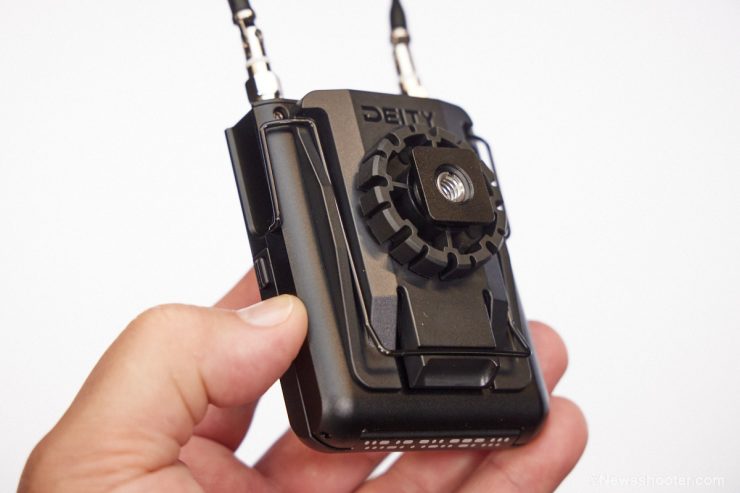
The THEOS D2RX has a plastic cold shoe mount with a 1/4 20″ tap that is attached with metal wire. This is a common type of mount and works fine. It’s easy to take off for bag use and doubles as a belt clip.
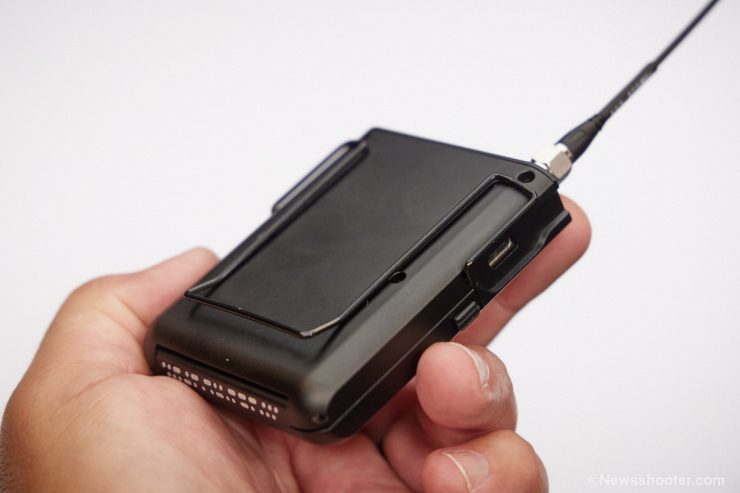
The D2TX uses the same metal wire to attach to a belt or other clothing. Again, it’s the same as many on the market.
Frequency Antena Options and Pairing
Since THEOS offers the 3rd most spectrum on the market across all wireless mic brands in an individual device, they needed to include antennas tuned across the 400mhz spectrum.
The DBTX and D2RX come with SMA antenna ports, allowing you to swap out antennas to fine-tune to the frequency in use. Removable antennas are great as they make packing and transporting them easier. Also, being removable will make them less prone to damage.
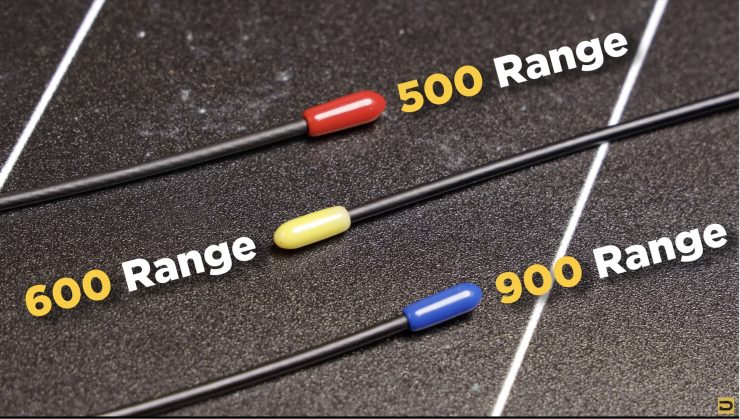
I think it’s excellent that Deity provides three range types to match the frequency you use for the best performance. Anything to give you an edge in getting the best possible signal is good.
The kit includes the following:
- RED 500
- Yellow 600
- Blue 900
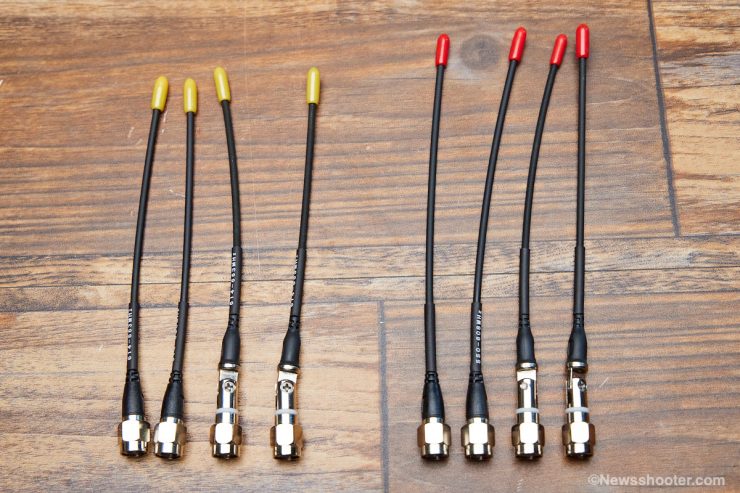
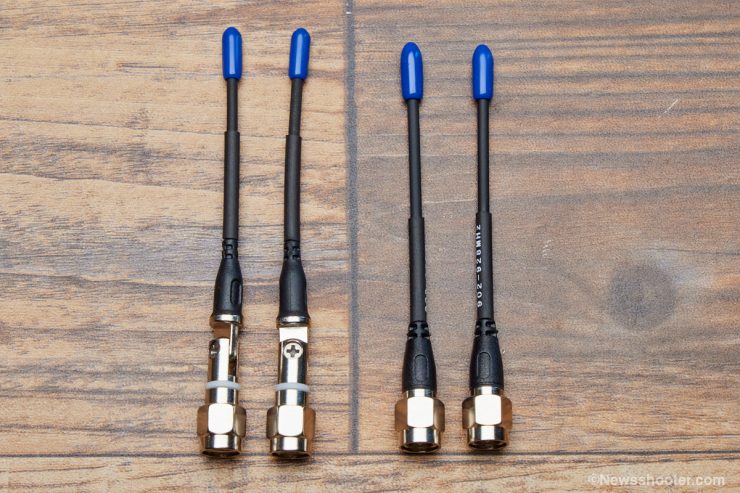
Each antenna set is labeled for the frequency range and color-coded for convenience. The hinged set is for the RX for mounting flexibility, whether in a verticle or horizontal position. It will usually be horizontal on cameras, and in a bag, it will be standing vertically.
The version sold outside the US has antennas that the user trims to the proper length based on the band.
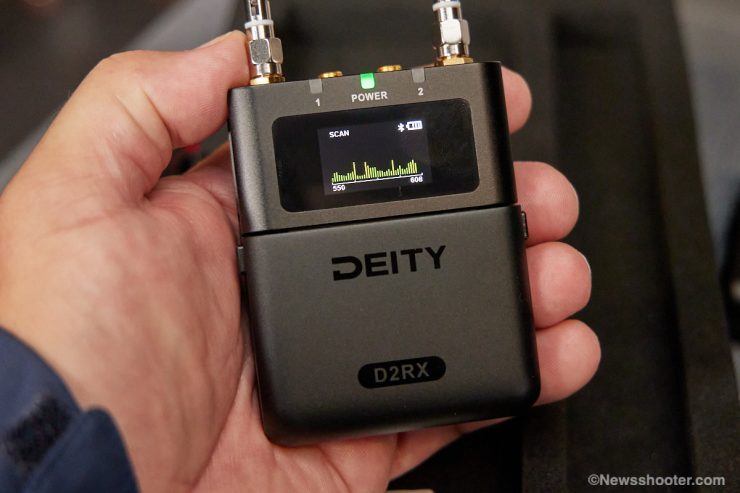
You can use the Sudus Audio app or the RX to scan for the strongest signal and pair the TX after. It’s very simple and works well.
Batteries Included
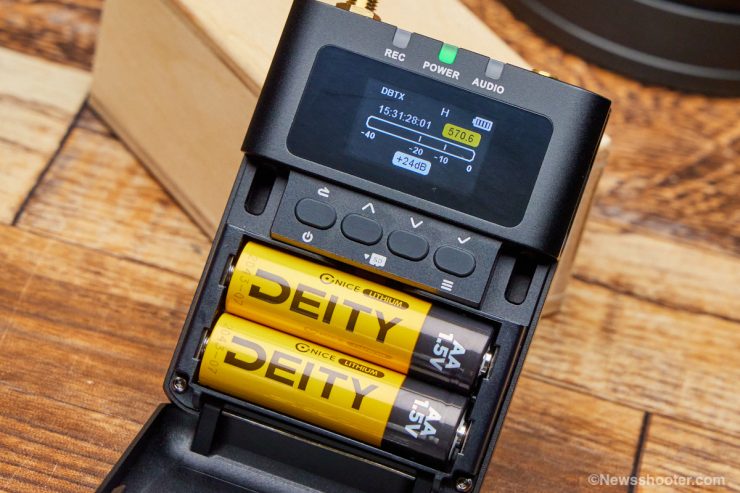
The kit comes with six high-capacity, Deity-branded 1.5v AA batteries. I appreciate the included batteries, You get 12 hours of operation with the included 3000mAh batteries.
Wireless Range
The Deity THEOS has a stated range of 425 feet or 130 meters. One big advantage of the THEOS is the ability to scan for the cleanest channel and use the antenna for the band to get the best possible signal. This is very cool, especially for a price range the THEOS hits.
A plus of the UHF system is that “line of sight” isn’t as important as 2.4GHz systems, so you have a little more flexibility if the subject is moving around and the body obstructs the transmitter.
Range Test
I used the RED 500 range antennas and scanned in the 550-608 range block. THEOS selected 571.8 as the best range, and then I paired the TX that was set to 50mW power. You can select 10mW, 25mW, 50mW, and 100mW. The advantage is that if the range is working well, you might be able to lower the power, making the battery last longer on the TX.
THEOS and I walked on a long, straight neighborhood street and got 575 feet or 175 meters with the transmitter on my back away from the receiver before the signal started to drop. The “line of sight” test was even better at 920 feet or 280 meters. This is impressive and goes beyond the stated range.
What’s important to remember is that if you have issues, you can select up to four different range banks plus save a few for recall. The options are great to have if you end up in different locations frequently.
I walked around my home inside rooms and went outside without issue. If you take the receiver a longer distance from the inside of a room, you get connection issues, but that is the case with all UHF systems. They can only be so good. It also depends on the environment but not as much as the GHz systems with a crowded spectrum. If you run into issues, you can rescan to find a stronger cleaner channel.
Recording to Micro SD Card
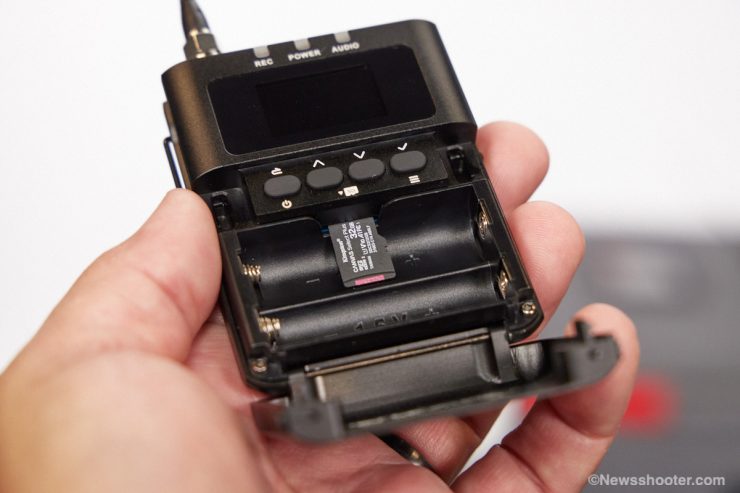
This is an excellent feature, making the DBTX much more useful. It records in two format options. 24-bit and 32-bit float as a .wav BWF file. 32-bit float is wonderful as you can adjust the levels in post without introducing noise, so nailing your recording levels is not as important. The flexibility is great, but it comes at a higher file size. I say it’s worth it! You must remember that other variables like handling noise, wind, and anything other than level will not magically be fixable. This is why placing the microphone correctly and using wind covers is important if you can’t monitor it. Always risky!
Unfortunately, for US consumers, you can’t record and transmit simultaneously due to a patent infringement. The rest of the world has the option to record and transmit simultaneously. Don’t get me started! Zaxcom has the record while transmitting patents that are set to expire in 2030. Until then, companies will have to pay Zaxcom if they are willing to license the feature or face legal action.
When using the recording feature, the “RF POWER” on the TX has to be set to OFF and RECORD selected. Now, you can use the Record function with the function button and the Sidus Audio App. You can monitor the recording with the 3.5mm headphone jack on the side.
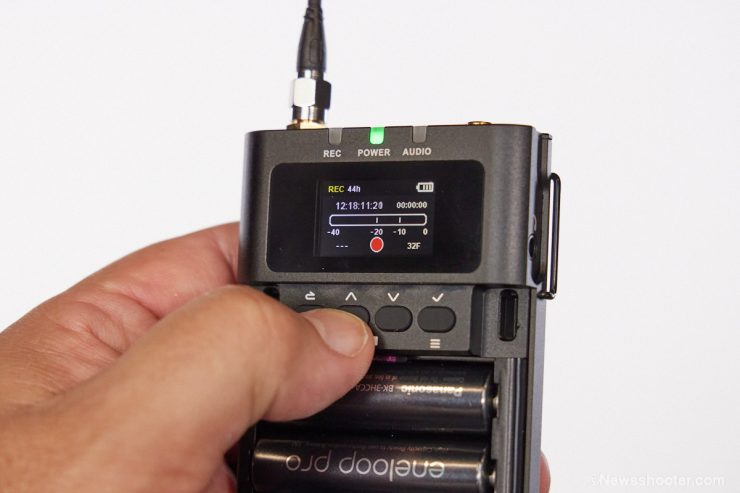
A quick way to access the record function is to long press the up button until the record function pops up on the display.
The built-in recorder features an EIN self-noise of -130dBu (A-weighting, gain at +30dB, 150ohm source impedance). The kit includes a 32Gb Micro SD card and can handle up to 128Gb capacity cards.
Included Deity W.Lav Pro
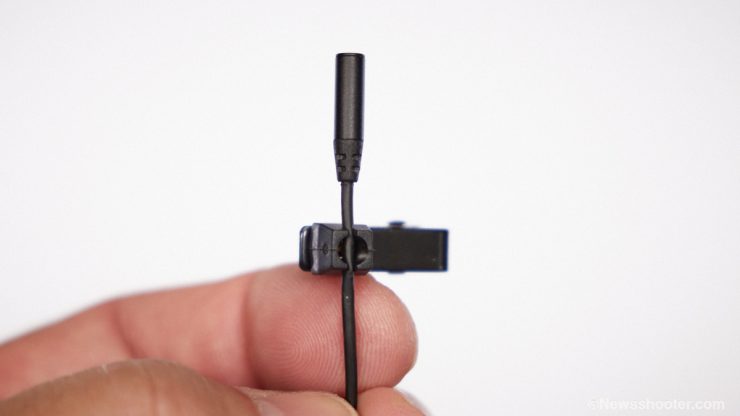
You get two Deity W.Lav Pro lavaliers with the kit. The Lavaliers are an excellent addition, as they sound good, and if this is your first audio wireless kit, it gets you up and running quickly. The mic clip attaches to the cable and has a tight fit.
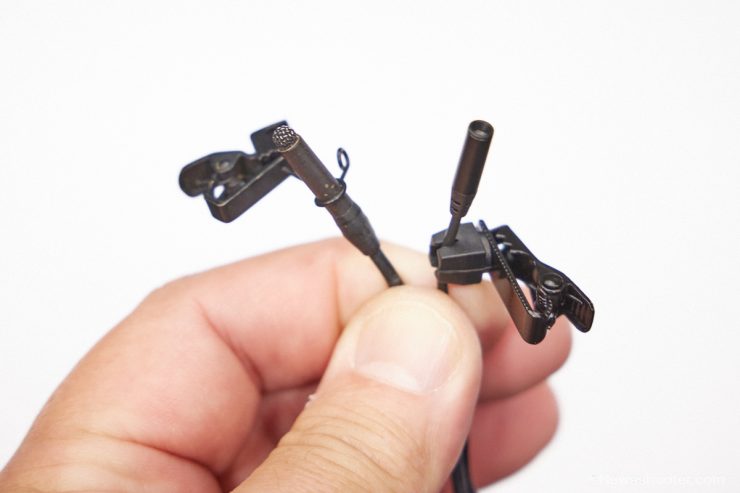
I’m always concerned when attaching this style, as you do have to use some force around the lav capsule. I feel that is a potentially fragile area where the cable connects to the lav mic. I might be wrong, and only time will tell.
The COS 11D mic clip attaches to the lav capsule. This design is better as it’s very secure, and I don’t have to worry about the cable.
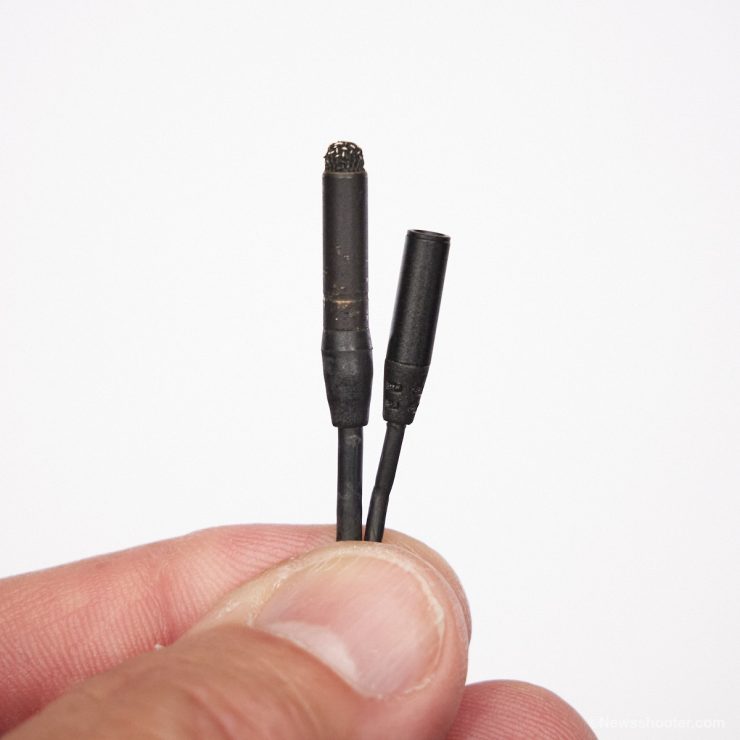
I use Sanken COS 11D lavs. They sound great, but they cost a lot at $389 for the 3.5mm locking connector version. I know many of you already invested in 3.5mm lavs, and the good news here is you can use them, but not a Sony 3.5mm wired version, as they have a different wiring scheme. All Sennheiser-compatible 3.5mm lavs will work.
Here is a sample of the Sanken COS 11D and Deity W.Lav Pro.
Here is a sample of the different sounds of both the Sanken COS 11D and the W.Lav Pro. It’s best to use a good set of headphones to hear the different tones.
Timecode Options
With the TX the internal recording will have SMPTE timecode embedded. This is great as it allows you to run LTC timecode on a mirrorless camera that doesn’t have a dedicated TC port or use the TC-1 connected to a dedicated TC port—match made in heaven. The D2RX doesn’t offer a built-in timecode generator to feed the camera. You will need a TC-1 or other TC device that syncs with the Deity.
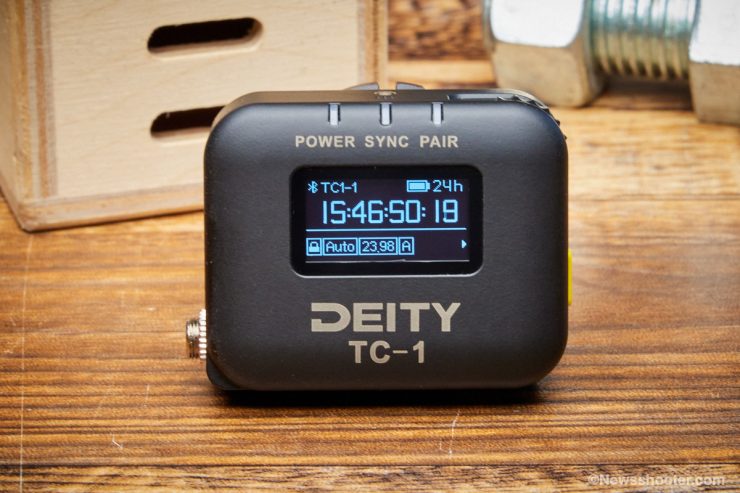
The advantage of staying in the Deity ecosystem is syncing is simple with the TC-1 and Sidus Audio. With the TC-1, you can sync all devices at once. If you use other TC products, they must jam each TX and plug into the camera’s TC port or mic input to record the LTC TC track. It’s best to leave a TC device plugged into the TC port instead of jamming. This way, no drifting will occur, and the TC will be spot on.
You lucky souls in the rest of the world can have both recordings with the TX and transmit to the camera for monitoring and recording internally. So jealous! But you should still use a TC device for the camera to make syncing in post as easy as possible, especially if your camera has a dedicated TC port.
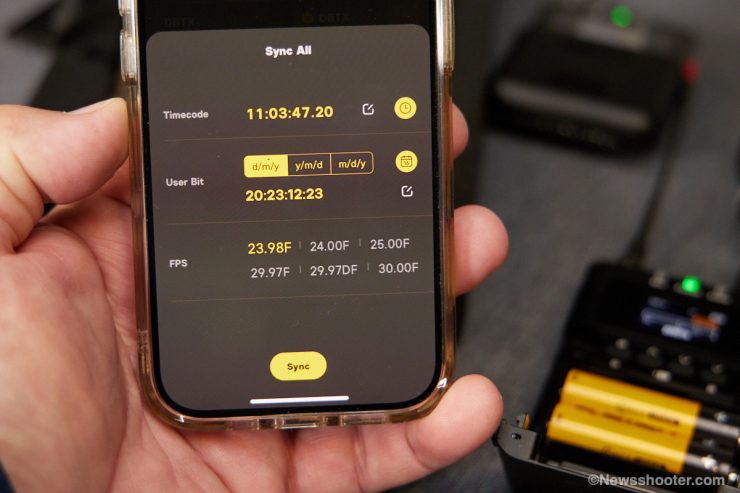
It’s great to have a portable recorder built into the DBTX, and since the system can be integrated with the Deity TC-1, you can have a uniform timecode. The DBTX can be synced via the 3.5mm jack if you are also using 3rd party timecode generators.
You need to use the Sidus Audio app to sync the timecode on both transmitters and RX. The Deity TC-1 can also be used to sync all devices simultaneously. You can’t do sync from the the TX or RX alone.
The timecode recorded on the Micro SD card is SMPTE timecode, not LTC. This is much better as you don’t have to do conversions before importing into your NLE of choice. The timecode is baked into the file.
This is a big deal as other systems like the RODE Wireless Pro use LTC to record an audible (LTC) timecode that must be converted for Premiere Pro and Final Cut Pro to read the TC. DaVinci Resolve supports reading LTC natively. I hope shortly, the other guys will get on board with LTC natively as well.
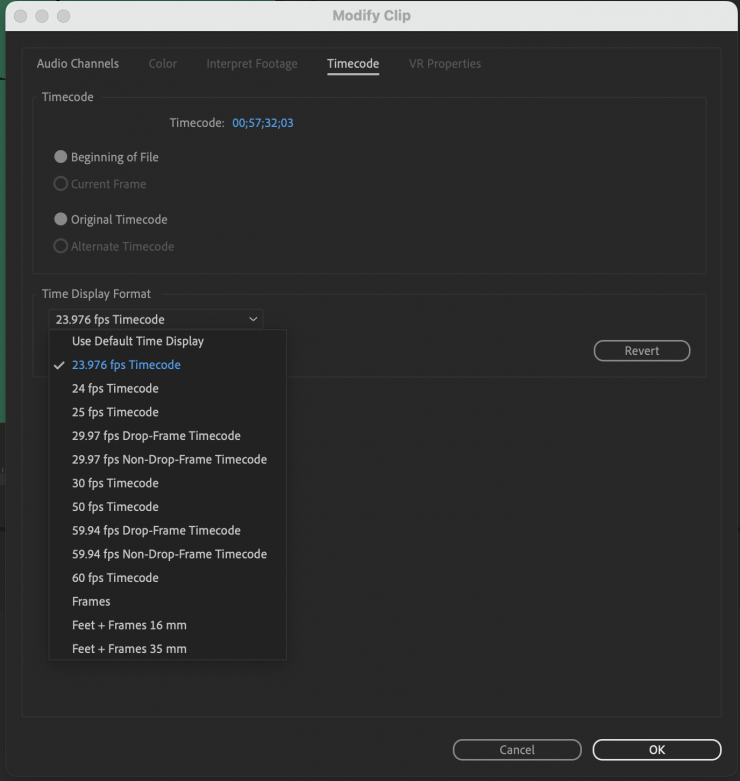
In Premiere Pro, you must change how the NLE reads and displays the timecode, or it will be off by several seconds. Right-click on the audio file select Modify/Timecode, and select the timecode that the recording was set to on the THEOS.
D2RX Duel Channel Reciever
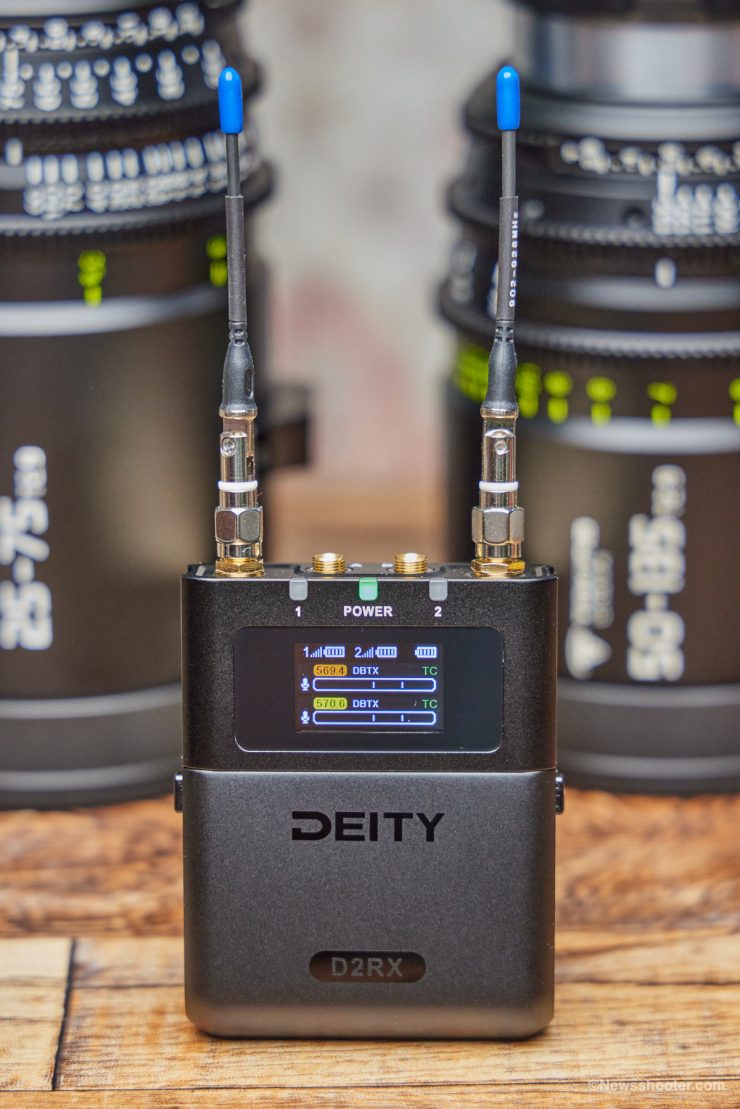
Deity has done a great job making the dual-channel D2RX receiver compact. It’s a touch larger than the transmitter and comes with a cold shoe mount that attaches with a metal wire clip similar to other brands. There are no other mounting options on the D2RX body; however, a 1/4 20″ tap is included on the cold shoe mount.
The kit includes two 3.5mm to XLR cables to connect to a camera or sound mixer/recorder. If you use only one RX, the “B” 3.5mm output can be used as a headphone jack to monitor the audio. You have a few options for setting up the two channels.
In the OUT TYPE, you can have “A” output with a single RX or both RX sent to the single output. This will mix both into one channel and can’t be separated. You have the same option for the “B” output, but again you can select it for monitoring with headphones and have two channels feeding into the single “A” output.
Interface
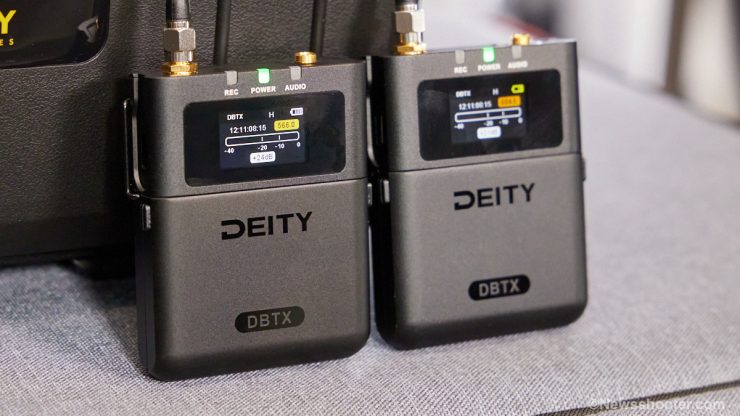
The OLED interface is crisp and bright. It’s easy to read and has the info you need. I like that you can see the battery power level for all three devices on the top of the display. Each frequency has a background color option with black text. While it’s a little harder to read, it’s nice to see they are different. Outside in the sun, the display can be tough to read.
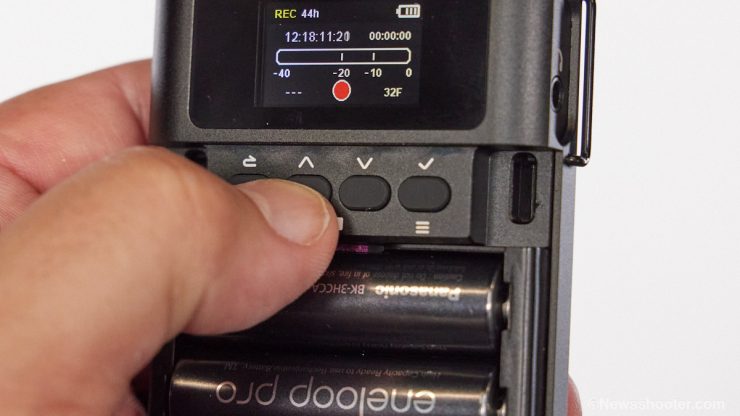
Scrolling the menu is also easy, with the four navigation buttons tucked away under the battery compartment door. It’s nice to have the buttons inside so no accidental changes will be made when wearing the RX or TX in a bag.
You can change the name of each RX and TX unit. This is handy if you have several systems going and want to make sure they don’t get mixed up. This is done in the “DID” option in the main menu.
Sidus Audio App
Maybe you hate menus and want to change all the settings differently. Well, there is an app for that!
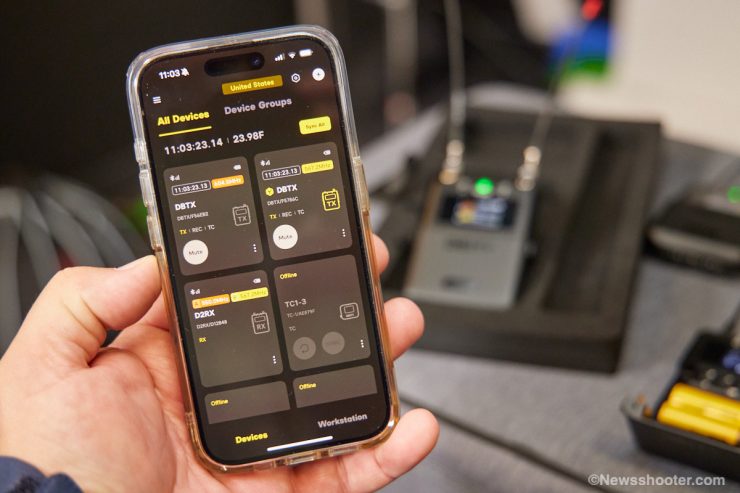
The Sidus Audio app allows you to perform frequency scanning and assignment, frequency coordination between multiple receivers, gain staging, and remote triggering of the backup recorder. This means you can make adjustments to your audio settings without having to touch the device physically. Nifty!
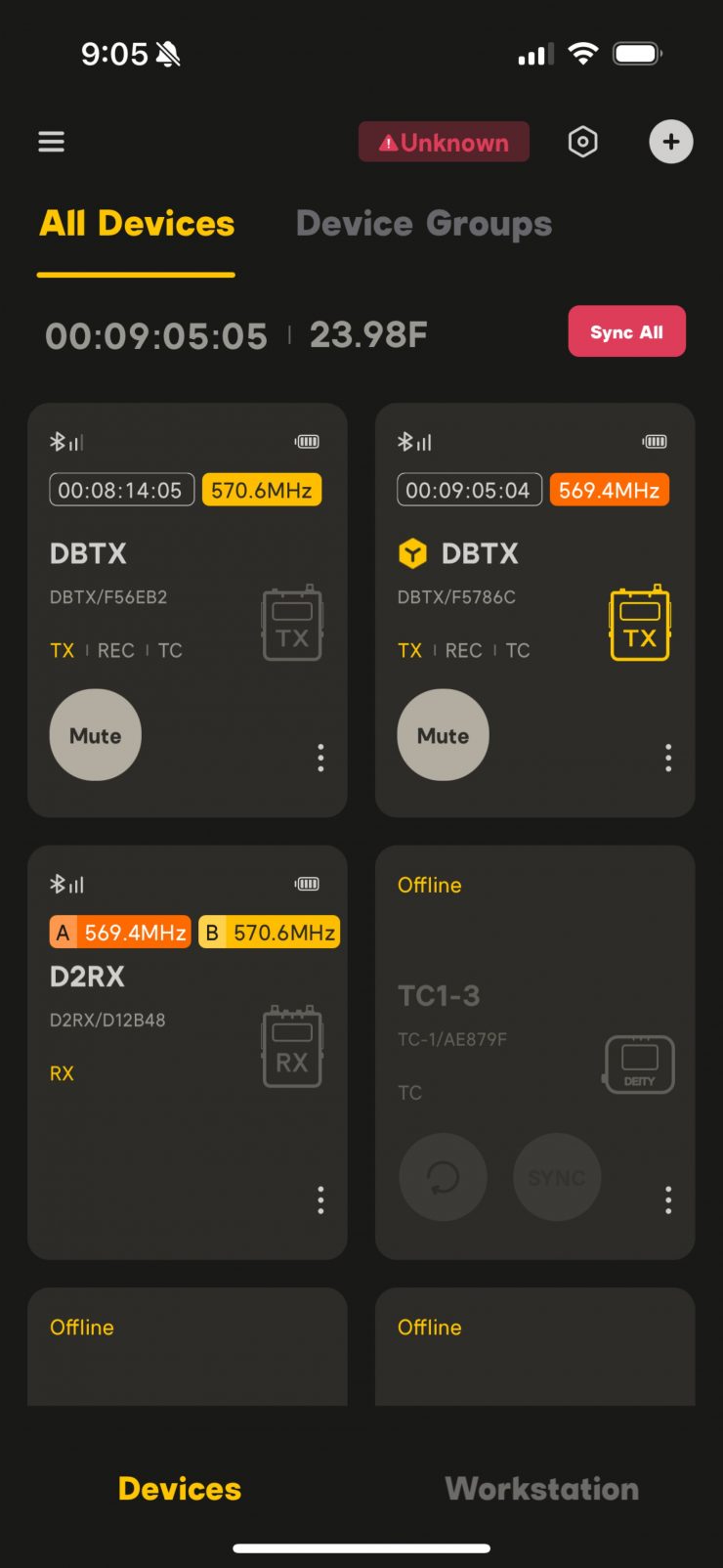
The remote control feature is especially useful if you need to work with multiple devices or those who need to adjust their audio settings quickly. It saves time and ensures you never miss a critical moment on set. The app also keeps your system firmware up to date. It’s a very useful app.
Wireless IFB
The THEOS can also be used as an IFB system. The video above shows how to set it up. Having options like this is great, and it adds more value to the overall system.
Competition
We have a lot of options when it comes to wireless audio kits, but not as many in the digital UHF space. Sennheiser EW-DP and Sony UWP have some affordable models, and Wisycom, Lectrosonics and Zaxcom are in the higher-end space that will cost easily double to triple the THEOS.
The Sony UWP-D27 is probably the closest in comparison as it’s UHF and a channel system, but it requires you to pick a frequency range and doesn’t include reorders in the transmitters.
Deity has done an impressive job of adding many features only available in high-end systems.
Final Thoughts
THEOS knocks it out of the park with many useful features at a great price. The kit is loaded and ready to go without any extras needed. Having a 32-bit recorder included is a big plus, but you will need a TC device to get everything in sync with the video. It would have been great to have a built-in Deity TC-1 in the RX, but that would add to the overall size and price of the receiver and kit. A stand-alone TC-1 retails for $199 and works great with the THEOS.
The included W.lav is also pretty good and can be hidden easily since the capsule is on top, and it’s tiny. It works great for hiding a microphone inside clothing. If you don’t already have a 3.5mm lav, I don’t feel you need to run out and get a higher-end model. Try it out, and I think you will be pleasantly surprised.
Is it Pro or Consumer?
Ah, yes, is it good enough for pro’s question? That isn’t hard to answer because many consumer products are used in professional paying gigs nowadays. Is a GoPro a pro product? Are mirrorless hybrid cameras “pro”? Yes, they are! Professional gear tends to have better usability. Sometimes, you can get pro features and usability at a good price; I feel that is what THEOS has accomplished.
I prefer the UHF systems over the 2.4GHz type. While nothing is as bulletproof as a cable, I feel paying extra for a more reliable system is worth it if you are a professional; you have to deliver. For the amateur, you can take more chances. But it’s also good to have both in the bag because you never know where you will end up shooting and the potential issues with lots of traffic causing dropout. Never leave home without a cable and hard-line mics. It’s always better to be safe than sorry.
In a nutshell, I like the THEOS wireless system a lot. Again, you get a lot for the investment, and time will only tell how well it will hold up.
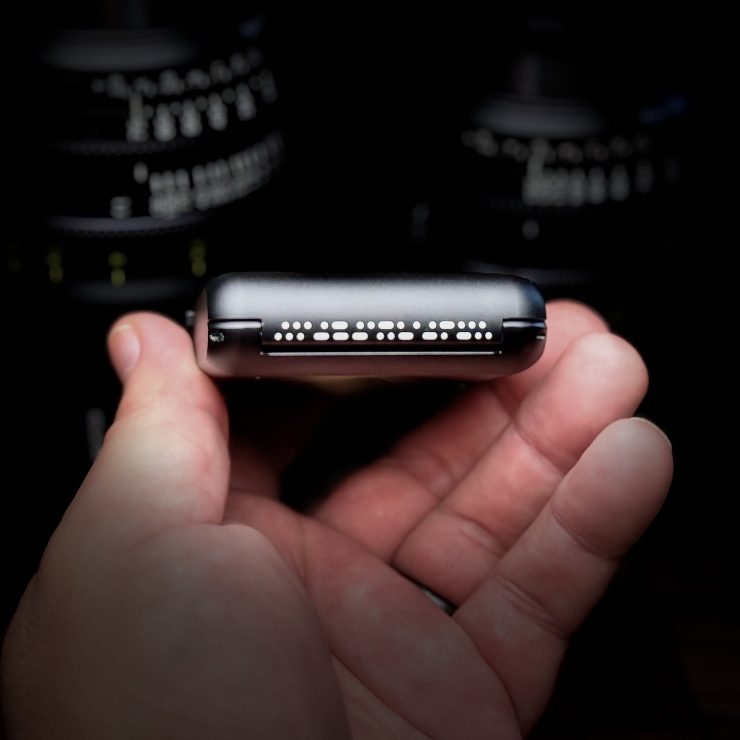
One last thing… I saw this visual pattern on the bottom of each TX and RX and couldn’t figure out what it was for. I did find out, but do you know what it is? Answer in the comments!
Pricing and Availability
The Deity THEOS retails for $1090 and is available now directly from Deity or your local retailer.



